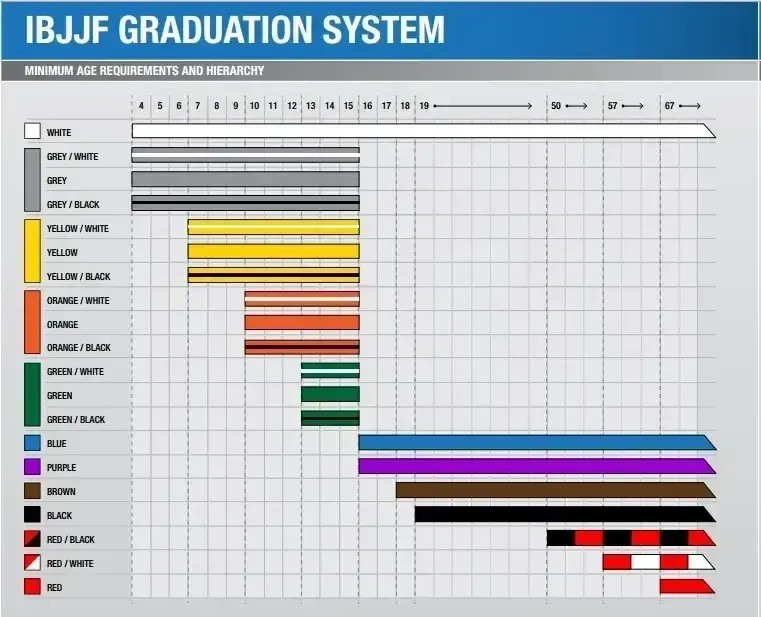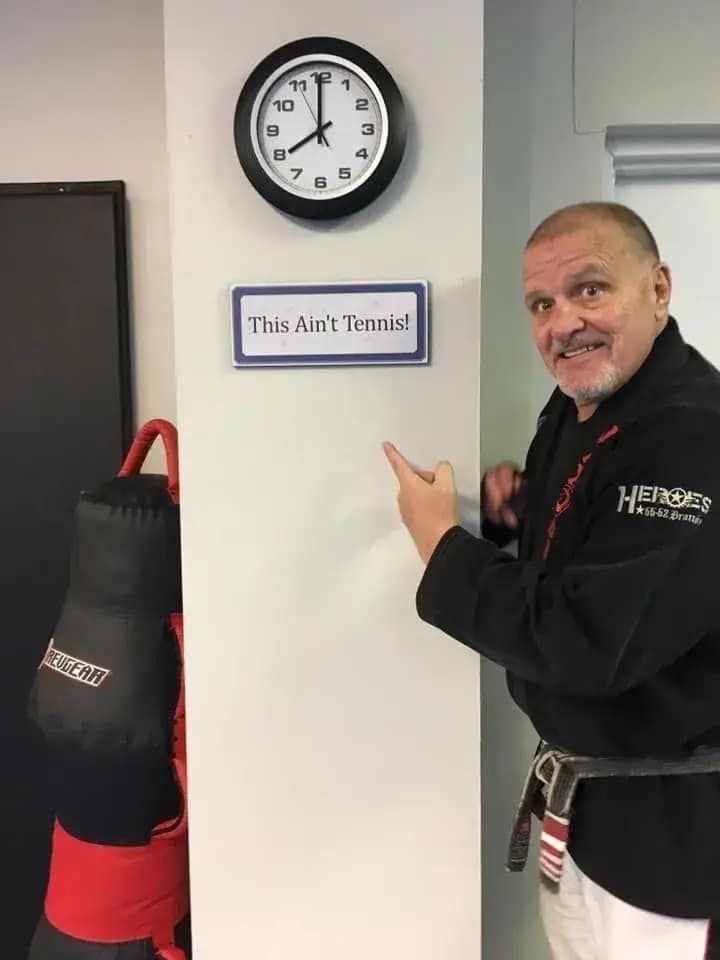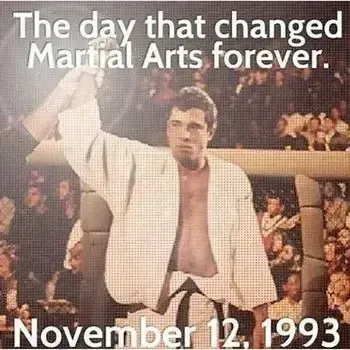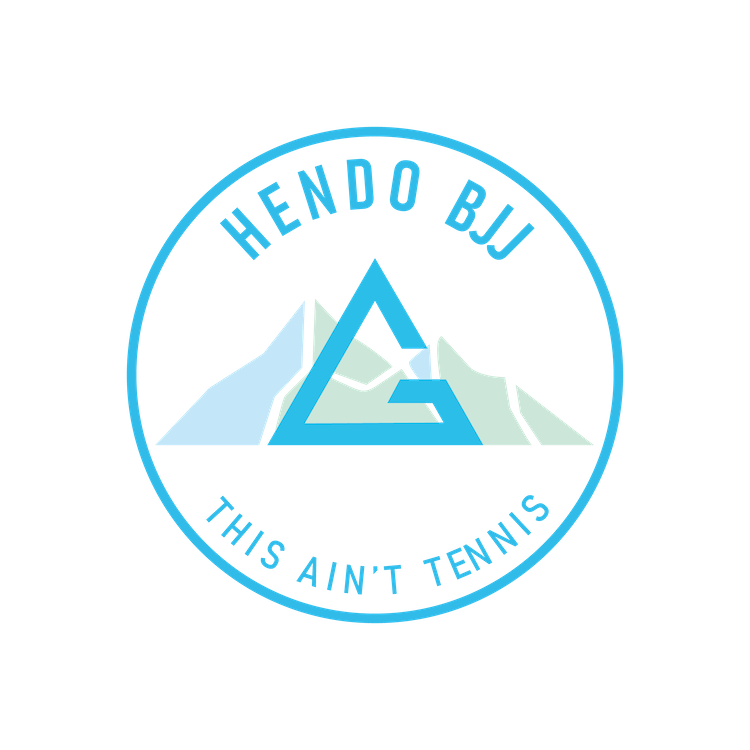Blog Layout
So…what should a new student know about the belts?
April 2, 2025
Kids Jiu-Jitsu Belt Ranks

The Hendo BJJ- Kid-Jitsu® Belt System
Belts in BJJ are not like some of the Taekwondo or Karate programs out there, as you will never see a child in a black belt, The highest belt in the Kids System of the IBJJF (International Brazilian Jiu-Jitsu Foundation) is the Green Black Belt.
In the adult BJJ system there are 8 belts: White, Blue, Purple, Brown, Black, Coral, Red-White and Red (Red is Grandmasters). It takes approximately eight to ten years to attain the black belt, which is mastery in it’s own right. There is a large degree of of subjectivity in the length of times to reach the black belt, depending on the Instructor. For example: One must be at least 16 years of age to receive the blue belt. (see above) The belts are earned on the mat and are not given or sold.
In Kid-Jitsu® we use 13 belts, with 4 stripes on each belt of the IBJJF belting system. We feel that if we can keep a child’s interest, consistency, proficiency that they move thorough the program in 4-6 years. I personally require the children to be at least 6 years old the begin the program.
IBJJF Children’s Belt Colors IBJJF Adult Belt Colors
White White
Grey-White Blue
Grey Purple
Grey-Black Brown
Yellow-White Black
Yellow Coral
Yellow-Black Red-White
Orange-White Red
Orange
Orange Black
Green-White
Green
Green-Black
The Green-Black belt is the highest belt in the BJJ system for kids. The kids can then test for the adult Blue Belt at 16 years old (see ages/#years in belt grid above). I have many kids mature at about 14 and wear their kids belts into my adult classes and test for their blue at 16…………and buddy, if they went through the kids program, through the Green-Black Belt…..they are going to be one very tough blue belt, from the get-go!
As we have an ongoing and rotating curriculum, our testing has a piece of objectivity with the techniques they are proficient at during testing, and subjectivity with how the student is progressing. Let’s talk about the belts.
I try to test the children about every 4-6 months. The students need to attend a minimum of 2 classes each week, on the average to be able to test for their next belt. Stripes are given that represent time on the mats, as well as proficiency and citizenship on and off of the mat.
To get a feel for what we look for in the belt testing, and for someone to wear their belt, this is what I look for:
White: The white belt is a brand new student. I expect them to learn the UPA mount escape, a guard pass, a sweep, some submissions, wrist grab escapes…… and I’d let them test for the next belt. This is the easiest belt of all to attain, as I do want them to know some basic fundamentals, but also show them the reward of a new belt. They have earned it.
Grey-White: Grey-White they should be getting more information on board and are able to pass the guard, roll some with some upper levels, and begin to put the pieces together. (Guard Pass, Side Control, Mount, Back Mount)
Grey: Grey belt; they are rolling fairly well, adding more techniques and helping some of the newer members with upa and basic positions
Grey Black: Grey Black should begin to become very good with sweeps and is hitting some submissions in sparring…game is beginning to come together
Yellow-White: This is where I begin identifying my leaders, and begin showing them more of the advanced techniques as the class is split by belts. Example: Armbar to Triangle to Omomplata set=ups…..they are “seeing” their game develop and understand the BJJ big picture.
Yellow: Leaders who have put it together but still rough at the edges. Needs work on the nuances of grips, dealing with larger people, and understanding the self defense end of jii=jitsu
Yellow-Black: we are adding more techniques and pushing them more to perfect technique. Their armbar must be superb, their sweeps crisp, their submissions clean, without using strength or force
Orange White: more of the same, better set ups, working from bad positions
Orange: very close, just polishing the edges
Orange Black: should be able to go into the adult class and hold their own with all white belts and a lot of blue belts. The should be able to see-do=and teach every technique in the curriculum to somebody in the adult class.
Green White:
The 3 green belts are Leadership Belts. Depending on age, these belts is where we are preparing the children to teach, assist in class, and get ready for a transition to the adult classes
Green
Green Back
AS I said there is some subjectivity. For example: if a child has any sort of handicap (for lack of a better word), we give them the benefit of the doubt and with promote them with time being the factor. If a child is extremely athletic, we are going to hold them to a high standard.
The techniques are the techniques and everybody needs to know them thoroughly and be able to articulate them to us, as well as perform them in a crisis situation or in sparring. If you see a BJJ belt on a child in our curriculum, you can bet that they have earned the belt, on the mat, with a lot of ‘mat time’ under their belt.
We will NEVER give a kid a higher belt than Green-Black in the kids curriculum. There is no such thing as a kids black belt in BJJ. It’s takes adults upwards of 10 years to attain a legitimate black belt, to give a kids a black belt, would be completely disrespectful to the sport and all the people who came before us.
One thing too about the BJJ is this…..it works. I would put my kids with a year experience in a street situation, and with little doubt, I know they can hold their own in a bully situation. They may not win a fight, and they certainly with not start one… but they know enough to gain position and control of the situation and not take any damage. To me, they didn’t lose, so they win.
I recommend you let your kids try the program. We are not flashy, we are just effective. We are not bullying folks and we certainly are not going to be bullied.
There is just a certain confidence when you know something………and others pick up on this confidence. Give your child the gift of this confidence by allowing them to train in our Kid-Jitsu® Program. You will be glad that you did.
Good Training,
Prof. Larry Shealy
“Train Hard, Train Smart…Train for LIFE!”
PS: next time I will further explain the adult belts
Share
Tweet
Share
Mail
Hendo BJJ BLOG

April 2, 2025
PCS and the Hierarchy of Positions Let me be the first one to tell you, Brazilian Jiu-Jitsu is a complex sport. There is a lot to learn, and the learning never stops! I’ve been at it over 20 years and I literally learn something new every day. That is the beauty of the sport….it’s like learning to play chess, when all you’ve ever played is checkers. Though it is complex, if you begin with a good, firm, solid foundation, the sky is the limit for how proficient you can become with your own personal game, as well as the students that you teach. It’s like building a house, a solid foundation, with good framing makes for a solidly built house. A poor foundation is like a house of cards…..it may look pretty, for a minute, but having no foundation, it will soon collapse. With all that said, let me explain how we are going to build our students game, how we will ‘lay it out’ for them, and how we will put them in a mindset of ‘knowing’ that they know what to do from each position. First let’s start with our mantra of P.C.S.. P.C.S. is the Acronym for POSITION, CONTROL, SUBMISSION. Let’s address Position. Our theory is to get to a position and maintain that position. For example, if you pass the guard, get a good firm side control before you attempt to mount or finish. I’m not saying to stall, or not fight. I’m saying to control the position before you move forward. We are always pushing forward (and I’ll talk about that in a minute when we discuss hierarchy of positions), and not getting in a hurry to a point where you do something stupid and lose the position. CONTROL: I’ve touched on the control portion. Get to the position, control the position. There is nothing worse than working to get to a position and then losing it. Especially in a fight! Be patient. Get to the position, and play like you’ve been there before. Know in your heart that you know what to do, and have a plan to do it. All the reps that you put in at the Academy will prepare you with this attitude. Position and Control…….gives you confidence, and set’s up the Submissions, or at least puts you in a position to begin looking for them. SUBMISSION: As you learn the position and control game, you will learn submissions along the way. Submissions can be hit from virtually all positions and in transitions from position to position. Trust the Position and Control game, and trust me, the submissions will be there. It’s almost ‘magical’ how they appear! Lol. That’s a brief glimpse of the PCS Game, and we will discuss this throughout our relationship together. With that brief set up, now let’s look at the hierarchy of positions and how to put that into your ‘mental’ preparation game for the kids you are teaching. HIERARCHY of Positions. For every position there is in Jiu-Jitsu, there is also it’s opposite position. A top and a bottom. A best case and a worst case. Let’s look at this on a totem pole and see the hierarchy. Best Case to Worst Case: Back Mount with Hooks Mount Knee Belly Side Control ½ Guard Guard ½ Guard Side Control Knee Belly Mount Back Mount with Hooks (There is another position that we will deal with later and it’s called the turtle position, and I cover North South when teaching side control) The way we teach the kids this is to visually go through each position. A top and a bottom, starting with back with hooks, and show them how to go from position to position and work our way up the hierarchy. This gives the student an awareness of what we need to next. They learn to use a specific technique or techniques to get to the next best position, or a position that is higher up on the hierarchy of positions module. For example: If you are mounted. Rather than freak out and try to strong arm your way out of the position, you simply use the UPA mount escape and end up in your opponents guard. You go from the second worst position you can be in, to a neutral position in his guard, by using one Jiu-Jitsu technique! Using this ‘mindset’ and with plenty of reps, over time, you will learn that you are ‘okay’ no matter the position that you are in. You get into a mindset that, “hey, I may not win this thing, but I’m sure not going to lose”. And then with that mindset, you continue to improve your game to a point that you can start winning! Look at it this way. If a child is in 3rd grade and weighs 50 pounds, and an 80 pound 6th grader bullies him or her on the playground. If the smaller child is able to neutralize the situation, and take no damage, who is the winner? I say the smaller child wins, if they don’t lose in that type situation. Another way of saying it is that we learn “not to lose”, and then we learn “how to win”. We also find that when one knows Jiu-Jitsu, they are less likely to need to ‘fight’ as they have a different air of confidence and carry themselves accordingly. Silent confidence speaks very loudly!!!! Trust the PCS approach as you help build your students game, and impress upon your students the hierarchy of these positions, and you will help them build a very solid foundation that they can build on for the rest of their lives. Insist on ‘perfection’ as they work the techniques and never settle for the using ‘short cuts’. Shortcuts make for weak foundations, and weak foundations make for poor jiu-jitsu in the long run. Take your time, have fun, and watch the Jiu-Jitsu houses become fortresses! Train Hard……Train Smart……Train for LIFE!!! Professor Larry Shealy Hendo BJJ

April 2, 2025
How Does MMA play into Kid-Jitsu® I may sound like a broken record, but some things are just worth repeating, over and over and over again. It’s probably because I’m a slow learner….who knows? Anyway, as I’ve said, I learned Gracie Jiu-Jitsu as an art that one does not need to be BIG or FAST or STRONG or ATHLETIC. The 1st four UFC Fights in the early 1990’s proved that to be true, as Royce Gracie shocked the martial arts world with his family style of Ground Fighting, that at that time, nobody in America seemed to be familiar with. Royce was not a menacing character, (though that stare could be quite menacing!), he was in the 175lb range, long and lanky, not particularly strong looking. But he had the family ‘secrets’ in the way of the leverage, timing and techniques of his craft, made him a martial arts sensation. He changed the fight game with….Gracie Jiu-Jitsu. So what does this have to do with Kid-Jitsu®? Well, it has everything to do with Kid-Jitsu® because that is the style of Jiu-Jitsu I’ve spent learning and training in for over 20 years now, and that is the ‘style’ of Jiu-Jitsu that I teach to my students, adults and children, and fellow Martial Arts Instructors. Please understand that in the Kids Classes we mainly stress Position and Control, and when it’s age appropriate, we share submissions, but NOTHING is full 100% like in an adult class. We are not deep in the collar, and we are not fully straightening arms for arm bars, or torquing shoulders with Kimuras…….SAFETY is paramount. Kid-Jitsu® and MMA The Gracie’s brought BJJ to the United States. Rorion Gracie had his younger brother fight in the first UFC’s to prove that Gracie Jiu-Jitsu was a superior fighting system, in comparison to the other styles of Martial Arts. In essence Gracie Jiu-Jitsu had already been proven in Brazil in Vale Tudo fights for many years with the likes of Helio in the early days, Carlson Gracie, and Rickson Gracie, among others making a mark in the fighting world in Brazil. The Gracie’s promoted their art as a Self-Defense system as well. As Kid-Jitsu® is a children friendly version of Brazilian Jiu-Jitsu, it only makes sense that we also have access to an MMA Curriculum for kids that is just as safe, just as organized and just as effective. And we DO! It is actually the Self-Defense System integrated into a no-gi training class for kids who have done Kid-Jitsu® for at least one year and have earned their yellow belt. So just like I did with the Kid-Jitsu Program, I’m using the same principles, and simply taking the Gi top off with the kids, and doing the techniques from the Self Defense of Jiu-Jitsu. We go from Take Downs to Positional Control to finishes. We do not teach punches and kicks in the KJU-MMA, we teach the kids how to ‘keep their Jiu-Jitsu honest’. By that I mean, we teach them how to block or avoid punches in the various positions. They do not take shots to the head or body as no punches are actually being thrown, we just teach avoidance by their positions in controlling their training partners arms. We teach take downs, and we teach their defenses. We teach avoiding sucker punches, and someone storming you throwing punches. We teach the clinch We also teach takedowns from the clinch We teach the Vale Tudo guard (teaching to know how to not take damage from punches in the guard) We teach getting positive positions, and not taking damage from bad positions….and many many more! In essence, we are teaching the kids how to ‘defend’ themselves in actual situations, which they may very well run it to on the street. We teach our kids to avoid fights at all costs…..but with a bully, sometimes the fight comes to the child and they must be prepared. Why do I call this self-defense aspect of our kids program MMA? I named it this mainly because I didn’t want to call it ‘street fighting’, or anything with the word bully in it, because I’m sick of hearing about the bully. I’d rather get kids trained up to deal with these guys. And most people wouldn’t know what Vale Tudo means. (no holds barred)…. Plus MMA is the buzz word with the kids and adults alike…..and they LOVE IT! The kids love the techniques, they love to take the Gi tops off and learn the various grip changes, different sweeps not using the gi, different take downs. They also embrace the faster version that the Jiu-Jitsu takes when there are not so many handles to hold on to like we have with the Gi. Also, the children LOVE to standing techniques from the various grab escapes or defenses, to the defenses from the standing chokes like the Lion Killer and the Guillotine. I believe that kids need to KNOW THESE DEFENSES, because most kids have access to the UFC and Bellator Fights and one knucklehead using these chokes on a child can be disastrous, so I want them to know how to escape problematic issues that may confront them in a crisis situation. Anything to do with submissions we handle with GREAT CARE, and GREAT SAFETY PRECAUTIONS. In all of our training with the kids, when we teach other instructors, and when we teach our adult students…..We ALWAYS put safety first in Kid-Jitsu®. In my way of thinking Gracie Jiu-Jitsu brought MMA (Vale Tudo) to the states. Everything that Royce Gracie used in his UFC fights, was Gracie Jiu-Jitsu. Only a sliver of what they know and teach is used in the MMA fights. The beauty of Jiu-Jitsu is that what we as average people….men, women and children can learn to defend ourselves, is essentially the same as used in the Octagon, and it’s effective in the ring, cage, and with the bully. That is why I teach the BJJ Self-Defense System in my school and in my Kid-Jitsu® BJJ for kids.. Partnering up with Rise MMA allows the kids the get the best of all MMA disciplines. Good Training! Professor Larry Shealy, BS, MBA Rigan Machado Black Belt Instructor Founder, Kid-Jitsu®
